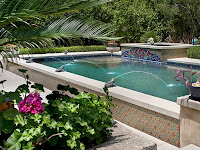Tips on Upgrading Your Pool Filter
If you are trying to figure out what size swimming
pool filter to purchase for your pool, things are complicated by not only the
different filter sizes but also by the different types of filters. So directly
comparing one filter type to another is not an exact science. Here is a
breakdown for you on the size comparisons across the three different types.
The first thing to make a note of is that in almost
every case going with the largest filter size possible for your pool will pay
off. If you have a 20,000-gallon pool you can get away with a 100 sq. ft. cartridge
filter but you will be cleaning it every month and you may have water quality
issues. Many pools in Florida work with these single cartridge filters and it
is certainly rated for that size pool, but I wouldn’t recommend such a small
filter. That same pool with a 420 sq. ft. cartridge filter will go 6 months in
between cleaning and you will have zero water quality issues and great flow.
Water quality issues would be cloudy water, algae and the like.
Here is a good example of this from my pool route. A customer
had a 25,000-gallon pool with a 36 sq ft D.E. filter on it. We upgraded his
D.E. filter with a 420 sq. ft. cartridge filter. The flow had increased so
dramatically that we had to divert half of the return flow to the attached spa so
that the pool wasn’t like swimming in the ocean! The flow increased dramatically
and all the issues I had with the pool disappeared overnight. So upgrading to a
larger filter can really move the needle if your pool is experiencing water
quality issues.
So how would you get a good size comparison between
the three filter types? I think you have to work off of a ballpark figure since
all of them filter the water in a different way. Here is the best guess chart for
you:
36 sq. ft. D.E. Filter is equal to a 200 sq. ft.
Cartridge Filter and a 150-200 lbs. Sand Filter
48 sq. ft. D.E. Filter is equal to a 320 sq. ft.
Cartridge Filter and a 250-300 lbs. Sand filter
60 sq. ft. D.E. Filter is equal to a 420 sq. ft.
Cartridge Filter and a 350-400 lbs. Sand Filter
100 sq. ft. Quad D.E. Filter is equal to a 520 sq. ft.
Cartridge Filter and a 450-500 lbs. Sand Filter
Since a D.E. Filter uses Diatomaceous Earth (D.E.) the
filtration area is very small but highly effective. In fact, D.E. Filters can
filter down to 3-5 microns making it the best filtration as far as microns go.
A Cartridge Filter can filter down to just 15-20 microns and a Sand Filter down
to 30-40 microns. So if you are just comparing filters by how good they filter
down to D.E. is the winner. If you are looking at sheer filtration area then the Cartridge Filter is the clear winner. With filtration areas of over 500 sq. ft. nothing
compares to it. But since it uses a cloth basically to filter, even though the
surface area is greater it doesn’t filter as efficiently as a D.E. Filter.
For ease of use, a Sand Filter can’t be beaten. All you
need to do when it gets dirty is backwash it and of course, change the sand
every few years. But you don’t need to take it apart and clean it every few
months, nor do you need to recharge it every time you backwash it. The sand
that is in their stays in there and you couldn’t ask for an easier filter to
maintain. If you are looking mainly for ease of use then a Sand Filter should
be your first choice.
Each filter type has their good points and their
drawbacks. There probably is no perfect choice but if you go with the largest
filter for your pool based on the gallons of water, the better off you will be.
The larger filter allows for a better flow rate, better overall filtration, and
better water quality. Although the upfront cost may be more it will pay for
itself over the years in time and fewer chemicals used to maintain your pool. Think
about the time you will save with a larger filter in cleaning the filter and
also the energy cost as you can run the pool less with a larger filter. And
finally, with a larger filter, you will not struggle to keep the chemistry
balanced and therefore will use less shock and algaecide over the years. So a larger filter is a win-win across the
board.
YouTube Video Index: http://poolmandave.blogspot.com/2014/03/swimming-pool-tips-reviews-how-to-video.html – A
list of all of my videos.


Comments
Post a Comment